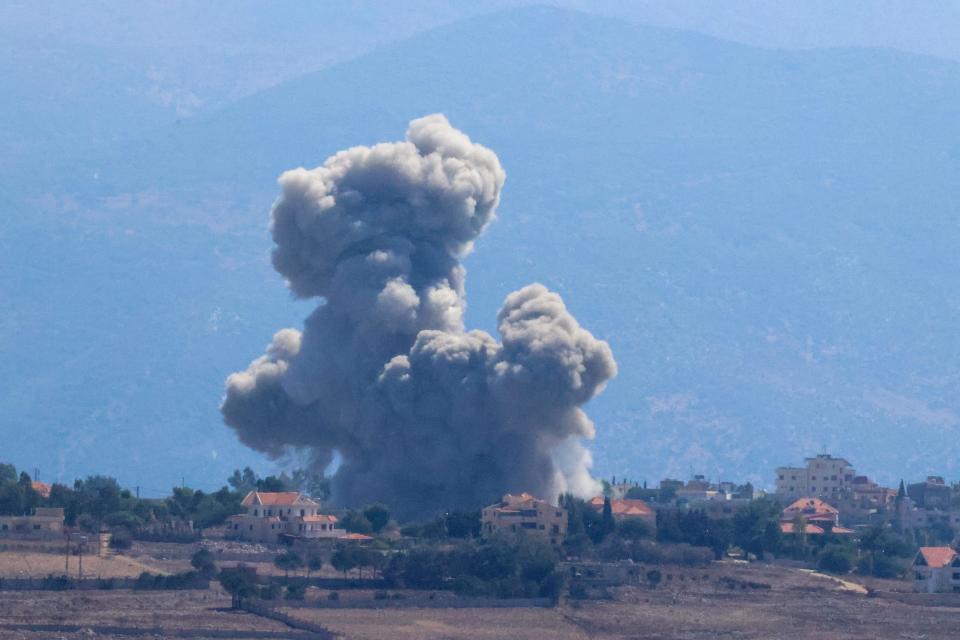-
Israel launched ground incursions into Lebanon on Tuesday, opening up a new war front.
-
The IDF said they were “limited, localized and targeted ground” raids against Hezbollah targets.
-
Deeper offensives could entangle its army in a new and prolonged war, military experts told BI.
Israel faces a security dilemma in deciding how far it should go in its operations inside Lebanon, according to security experts.
Early on Tuesday, the Israel Defense Forces said it had launched “limited, localized, and targeted ground raids” against Hezbollah targets and infrastructure in southern Lebanon — opening up a new front in the escalating conflict between Israel and the Iran-backed militant group.
The ground offensive comes after months of cross-border projectile exchanges and a series of Israeli airstrikes on September 27 that killed Hezbollah’s longtime chief, Hassan Nasrallah.
The IDF said its ground operation would follow a “methodical” plan, adding it would continue fighting until it achieved all its war goals.
But security experts told BI that the IDF runs the risk of prolonged conflict and increasingly bloody fighting in Lebanon should it decide to go further into the country.
“A full-scale Israeli ground offensive in southern Lebanon would not be an easy task,” Clionadh Raleigh, executive director of the Armed Conflict Location and Event Data Project, and Ameneh Mehvar, a Middle East regional specialist with ACLED, said in a joint statement.
They told BI that Hezbollah had been preparing for this scenario “for years” and that the IDF would “likely encounter more intense fighting than in Gaza, which could lead to greater Israeli casualties.”
Farzan Sabet, a senior research associate at the Global Governance Centre and the Sanctions and Sustainable Peace Hub at the Geneva Graduate Institute, went further in his assessment.
“One of the major risks involved in such operations is that Israel will squander the major strategic and tactical victories obtained against Hezbollah and become trapped in a military quagmire in Lebanon,” he said.
A more perilous terrain than Gaza
Israel’s ground operations inside Lebanon bear some resemblance to the ones it conducted in Gaza about a year ago.
In October 2023, the IDF mounted limited ground incursions into Gaza and called on Palestinians to evacuate to the south of the enclave before launching a broader offensive.
While the early stages of the IDF’s ground operations in Lebanon are similar to its early operations in Gaza, Hezbollah’s military capabilities, Lebanon’s political circumstances, and its topography make the country a whole different reality, security analysts told BI.


Sabet of the Geneva Graduate Institute said an Israel offensive in Lebanon will be “distinct” from the one in Gaza in that the IDF would be operating on a “much larger” territory against a “bigger and more sophisticated” adversary.
While the Gaza Strip is about 140 square miles in size, Lebanon is about 4,036 square miles.
Hezbollah is also estimated to have stockpiles of up to 200,000 missiles.
Burcu Ozcelik, a senior research fellow for Middle East Security at the UK’s Royal United Services Institute, said that the IDF’s limited ground raids across the Lebanese border would expose its troops to combat with Hezbollah fighters on a terrain that is Hezbollah’s “home turf,” and where it commands control over military infrastructure and local communities.
“This is not an area that is peppered with densely populated urban centers in the way the Gaza Strip is,” she told BI.
Raleigh and Mehvar of ACLED, meanwhile, said the nature of the operation in Lebanon differs from those in Gaza. Israel isn’t fighting against Lebanon’s government — unlike the de facto government in Gaza, they said.
As such, they do not expect an “extensive carpet bombing” and “ferocity” like the one seen in Gaza.
“Israel’s objective is to ‘diminish’ Hezbollah’s military capabilities and push it away from the border,” they said.
How far it should go
Israel has spent months conducting airstrikes and raids into southern Lebanon to degrade Hezbollah’s capabilities.


However, it remains unclear how deep Israel’s ground incursions might go, according to Raleigh and Mehvar.
They said the IDF will likely not extend beyond southern Lebanon due to the risk of getting “increasingly” entangled in a new “prolonged” conflict in southern Lebanon.
They added that “Hezbollah still retains much of its capability, including the missile stockpiles it has built up since 2006, which could be used against Israeli military and civilian targets.”
Sabet, meanwhile, said that history is “strewn” with examples of countries whose militaries entered the territory of another country for limited military operations but ended up engaged in costly and damaging long-term wars.
He mentioned Israel’s own “costly” experiences of invasion in Lebanon, including the Second Israeli Invasion of Lebanon of 1982 and the Second Lebanon War in 2006.
Since the Hamas October 7 terror attacks on Israel last year, Israel’s economy has suffered, with its GDP contracting by 20.7% in the last quarter of 2023.
In the long run, the war in Gaza alone could cost Israel 10% of its annual GDP, Yannay Spitzer, an assistant professor specializing in economic history and applied microeconomics at the Hebrew University of Jerusalem, told The Media Line last month.
However, those sums, and Israel’s overall military calculations, could quickly change if Iran gets involved on the side of Hezbollah in Lebanon.
A senior US administration official told outlets on Tuesday, that Iran was preparing to launch a ballistic missile attack on Israel.
“We are actively supporting defensive preparations to defend Israel against this attack,” the official said.
During a speech last week at the UN, Israeli Prime Minister Benjamin Netanyahu gave a warning to the “tyrants of Tehran,” saying: “If you strike us, we will strike you.”
He added: “There is no place in Iran that the long arm of Israel cannot reach.”
Read the original article on Business Insider







